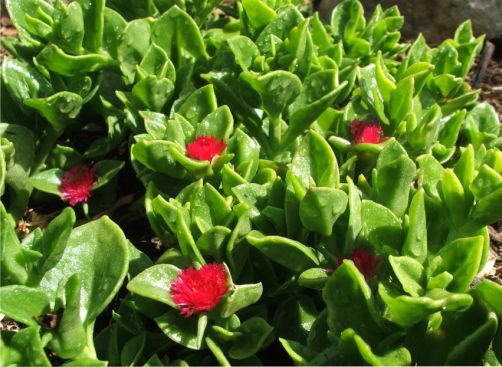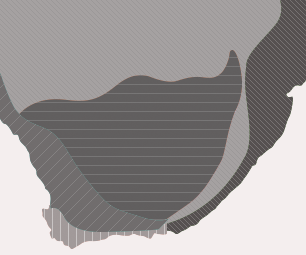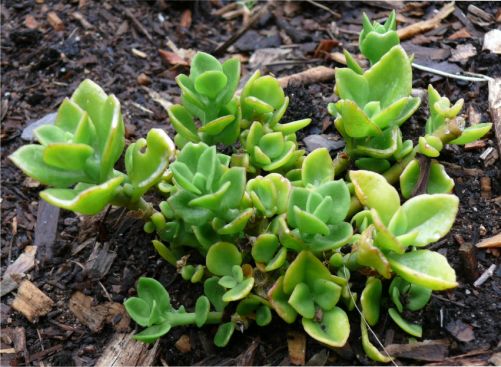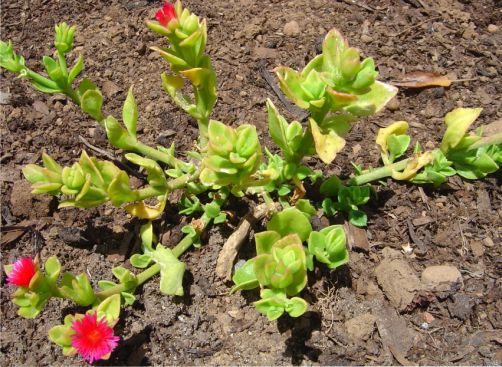Mesembryanthemum cordifolium
Mesembryanthemum cordifolium L.f. (= Aptenia cordifolia (L.f.) Schwantes)
Family: Aizoaceae
Common names: heart-leaf vygie, heart-leaf ice-plant, baby sun rose, red aptenia, carpetweed (Eng.); rooibrakvygie, brakvygie (Afr.); ibohlololo, uncolozi omncane, umjuluka (isiZulu)
Introduction
The glossy succulent leaves and bright magenta pink flowers are distinctive characteristics of the heart-leaf vygie. It is a well-known groundcover or creeping plant.

Description
Description
Mesembryanthemum cordifolium is an evergreen and fast-growing succulent, often a short-lived perennial, 250 mm high. The roots are fleshy and thick. The succulent stems are four-angled or rounded, up to 600 mm long, and grow flat on the ground. Bladder or water cells are closely arranged on the surfaces of the stems and shine in the sunlight. The green leaves are fleshy, flat, heart-shaped to oval, 60 x 25 mm, and are widely spaced in pairs. Bladder cells are scattered on the leaf surface.

Flowers are purple to red, shiny, small to medium, 15 mm wide and borne singly or in clusters on short flower stalks. Terminal flowers are found in the forks of the branches. The flowers are self-fertilized and flowering occurs from spring to autumn (August to April). Flowers open during the bright hours of the day (midday to early afternoon). The fruit is a capsule with four lidless chambers (locules). Each chamber contains one large black-brown seed with a rough surface.

Conservation Status
Status
Mesembryanthemum cordifolium is not a threatened species, it is assessed as Least Concern on the Red List of South African Plants.
Distribution and habitat
Distribution description
Mesembryanthemum cordifolium occurs naturally in the summer rainfall regions of South Africa at an altitude of 20-800 m. It grows along the coastal regions of the Eastern Cape and is also found in KwaZulu-Natal.
Derivation of name and historical aspects
History
The genus name Mesembryanthemum is derived from the Greek word mesembria, meaning ‘midday’, and anthemom, meaning ‘flower’, referring to the flowers of this group that typically open at midday (noon). Mesembryanthemum cordifolium was known as Aptenia cordifolia until 2007 when the genus Aptenia was reduced to synonymy under Mesembryanthemum. The former genus name, Aptenia, is derived from the Greek word, apten, meaning ‘wingless’, and refers to the wingless seeds. The species name, cordifolium, is derived from the in Latin words, cordi, meaning ‘heart’, and folium, meaning ‘leaf’, referring to the heart-shaped leaves.
This species is endemic to South Africa but is now grown all over the world. The genus Aptenia consisted of four species, all now placed in Mesembryanthemum and all occur in the summer rainfall regions of South Africa:
Mesembryanthemum geniculiflorum is an erect deciduous perennial with 4-angled branches, white to pale yellow flowers and occurs on dry flats in scrambling bush in Namibia, Northern Cape and Eastern Cape.
Mesembryanthemum haeckelianum is a succulent perennial with 4-angled branches that grows flat on to the ground, with flat leaves and pale yellowflowers. It occurs in karroid flats in the Eastern Cape, from Port Elizabeth to Alexandria.
Mesembryanthemum lancifolium is a perennial succulent, 300 mm high. It bears magenta flowers with narrow, lance-shaped leaves and occurs in Limpopo.
Ecology
Ecology
The shiny, bright flowers attract butterflies, bees and other insects. It is a drought-resistant plant, that tolerates high rainfall and irregular watering.

Uses
Use
Mesembryanthemum cordifolium is used medicinally as an anti-inflammatory, as a dressing (poultice) to reduce swelling and deodorant. The plant is also used as a love charm and good luck charm. Zulu medicinal uses include making a mild enema for babies; the black powder is used for vaccination against witchcraft (sorcery). Burnt stems and leaves are applied to aching joints.
It is also a popular and widely grown ornamental plant often planted on dry slopes or steep embankments to hold the soil and suitable for coastal gardens as it tolerates salt spray.
Growing Mesembryanthemum cordifolium
Grow
Mesembryanthemum cordifolium is vigorous, fast-growing, drought-resistant and a well-known groundcover. It is an ideal plant for coastal gardens as it tolerates sea spray and grows in sandy soil. It can be used in rockeries, on rocky outcrops, terraced slopes and along roadside embankments. It requires full sun or semi-shade and can be planted underneath trees. It grows in any well-composted soil and needs moderate watering all year. If grown in unfavourable conditions, the plant will die.
Mesembryanthemum cordifolium is easily grown from seed and cuttings. Sow seeds in summer. The plant can be divided and runners can be planted directly into the ground. Before planting, prepare the garden bed by digging over the soil; add compost and a slow-release fertilizer. Once established it requires less water. Trim or prune the plant to maintain its shape. The plant can become weedy.
References
- Bohnen, P. 1995. More flowering plants of the southern Cape. The Still Bay Conservation Trust, Still Bay.
- Court, D. 2000. A revised Succulent Flora of southern Africa. Balkema, Rotterdam.
- Goldblatt, P. & Manning, J. 2000. Cape Plants. A conspectus of the Cape flora of South Africa. Strelitzia 9. National Botanical Institute, Pretoria & Missouri Botanical Garden, Missouri.
- Herre, H. 1971. The genera of the Mesembryanthemaceae. Tafelberg, Cape Town.
- Hutchings, A., Scott, A.H., Lewis, G. & Cunningham, A.B. 1996. Zulu medicinal plants: an inventory. University of Natal Press, Pietermaritzburg.
- Joffe, P. 2001. Creative gardening with indigenous plants. Briza Publications, Pretoria.
- Klak, C., Bruyns, P.V. & Hedderson, T.A.J. 2007. A phylogeny and new classification for Mesembryanthemoideae (Aizoaceae). Taxon 56: 737-756.
- Pooley, E. 1998. A field guide to wild flowers of Kwazulu-Natal and the eastern region. Natal Flora Publications Trust, Durban.
- Raimondo, D., Von Staden, L., Foden, W., Victor, J.E., Helme, N.A., Turner, R.C., Kamundi, D.A. & Manyama, P.A. (eds) 2009. Red list of South African plants. Strelitzia 25. South African National Biodiversity Institute, Pretoria.
- Rowley, G.D. 1980. Name that succulent. Stanley Thornes Publishers, Cheltenham.
- Sajeva, M. & Costanzo, M. 2000. Succulents II. The new illustrated dictionary. Timber Press, Oregon, USA.
- Smith, G. 2005. Gardening with succulents. Struik, Cape Town.
- Smith, G.F. & Van Wyk, B-E. 2008. Guide to succulents. Briza Publications, Pretoria.
- Van Wyk, B.-E., van Oudtshoorn, B. & Gericke, N. 1997. Medicinal Plants of South Africa. Briza Publications, Pretoria.
Credits
Norma Lucas
Kirstenbosch National Botanical Garden
January 2009, updated April 2025
Plant Attributes:
Plant Type: Ground Cover, Succulent
SA Distribution: Eastern Cape, KwaZulu-Natal, Limpopo
Soil type: Sandy, Clay, Loam
Flowering season: Spring, Early Summer, Late Summer
PH: Acid, Alkaline, Neutral
Flower colour: Purple, Red, Pink
Aspect: Full Sun, Morning Sun (Semi Shade), Afternoon Sun (Semi Shade)
Gardening skill: Easy
Special Features:
Horticultural zones













Rate this article
Article well written and informative
Rate this plant
Is this an interesting plant?
User Comments
Tracy Frayne, South Africa
August 01, 2017 at 10:18 PMThe mousebirds in my garden LOVE this plant and a whole group of them at a time will come down and eat all the leaves off it, leaving behind just a sad looking stem. The plant recovers - it just looks awful for a while
Has anyone else experienced this?
Login to add your Comment
Back to topNot registered yet? Click here to register.